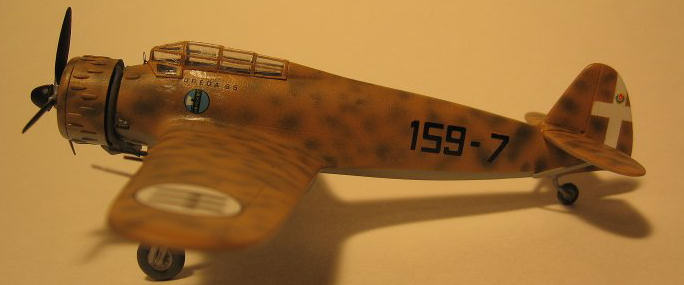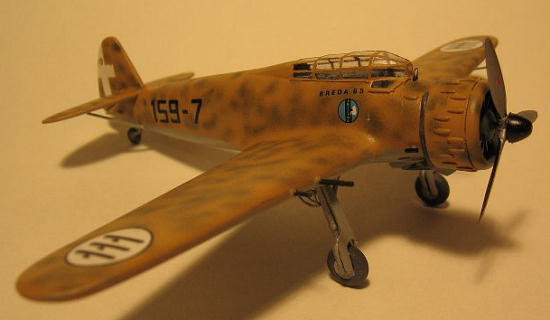
Azur 1/72
| KIT #: | 002 |
| PRICE: | $? |
| DECALS: | Three options |
| REVIEWER: | Brian Baker |
| NOTES: |
Early short run kit with vacuform canopies |

| HISTORY |
 Civil
War, it was found wanting in
several respects, and finally wound up being used primarily for reconnaissance
missions. Both two seat and single
seat versions were produced in quantity, and two different
radial engines, the 1000 hp. Fiat A.80 RC 41 and the 900 hp.
Isotta-Fraschini K-14, were used.
Later, a few BA-65 bis variants were produced with a
Civil
War, it was found wanting in
several respects, and finally wound up being used primarily for reconnaissance
missions. Both two seat and single
seat versions were produced in quantity, and two different
radial engines, the 1000 hp. Fiat A.80 RC 41 and the 900 hp.
Isotta-Fraschini K-14, were used.
Later, a few BA-65 bis variants were produced with a
During World
War II, those Ba-65ís that had survived pre-war service and the Spanish Civil
war were used in the Italian campaigns in
| CONSTRUCTION |
This is
one of Azurís very early offerings, and basically two variants are provided,
the single seat model and the type with the hand held machine gun in a
dorsal position. Molded in rather
brittle light blue styrene plastic, the kit has fine recess panel lines and nice
surface detail. There is one sheet
of PE metal parts, mainly for interior parts and one portion of the landing
gear, and a photo-negative instrument panel section is also provided. These are
somewhat visible through the vacuform canopy. The injection molded plastic
detail parts are somewhat crudely done, with some flash, but they can be trimmed
up with no real problems. All of
the parts, wings and tail unit, butt-fit onto the fuselage, but it is easy to
get them attached at the proper angles.
As can be expected in a short run kit,
some filler is required, but this is true with many models, so itís not a
problem.
I have
seen one other review on this kit that complains about the engine, and that it
is too small within the cowling, but I assembled mine according to directions
and found the engine to be one of the better features of the kit, although it
might be just slightly too small in diameter.
The major problem I found is the propeller.
Although there is not a lot of reference material available on this
aircraft, and not too man y
photos, many show the airplane with counter clockwise rotation, British style,
rather than clockwise rotation, American style.
The kit prop is American style.
The difference is probably that one of the engines most likely had
different rotation, but from the photos and reference material I have available,
I was unable to determine which one it was.
This is a problem that I am always aware of,
since Iíve spent my entire flying life hand propping airplanes, and
rotation is always a big issue. Of
course, some of the published
photos are sometimes printed backwards in reverse, and if no numbers or letters
are visible, it is impossible to tell which way the prop should rotate.
Anyway, I replaced the kit prop, which appeared to be too small anyhow,
using one from a Frog Fokker D.XXI, and it looks right to me.
y
photos, many show the airplane with counter clockwise rotation, British style,
rather than clockwise rotation, American style.
The kit prop is American style.
The difference is probably that one of the engines most likely had
different rotation, but from the photos and reference material I have available,
I was unable to determine which one it was.
This is a problem that I am always aware of,
since Iíve spent my entire flying life hand propping airplanes, and
rotation is always a big issue. Of
course, some of the published
photos are sometimes printed backwards in reverse, and if no numbers or letters
are visible, it is impossible to tell which way the prop should rotate.
Anyway, I replaced the kit prop, which appeared to be too small anyhow,
using one from a Frog Fokker D.XXI, and it looks right to me.
Another
issue is the bottom windows. The
kit provides a vacuform part for these, which is outlined on the fuselage
section, showing you where to cut the plastic.
One review I read stated that the single seat versions did not have the
belly windows, as they were primarily for the rear seat observer/gunner.
I decided
to leave them off, as I did the single seater.
Also, the rear gun position requires some cutting and fitting, although
the new part is provided on the sprue.
| COLORS & MARKINGS |

| CONCLUSIONS |
February 2011
If you would like your product reviewed fairly and quickly, please contact me or see other details in the Note to Contributors.